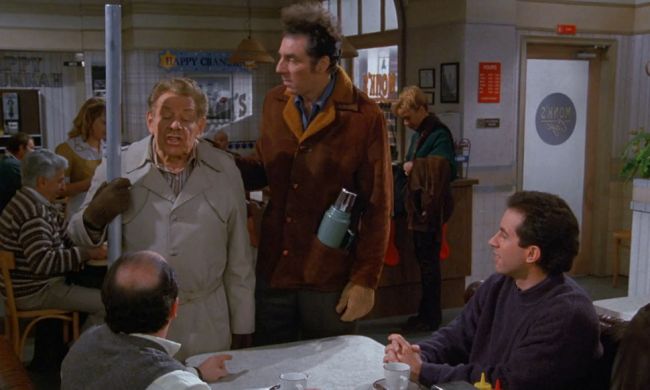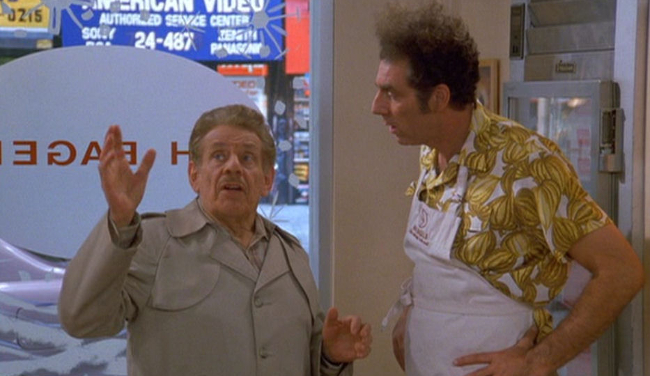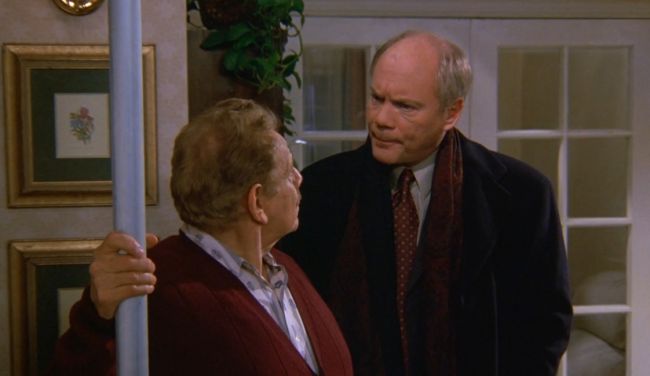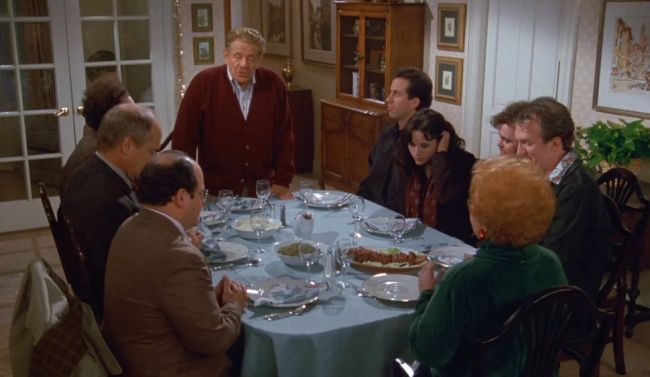
(ED. NOTE: This piece was originally published in 2015. We’re republishing it today — December 23, 2018 — because, well, today is Festivus. Enjoy.)
By the ninth and final season of Seinfeld, everyone’s favorite show about nothing had already contributed so much to our daily vocabulary. Shrinkage, spongeworthy, “No soup for you!” and yada yada yada – the well of relatable Seinfeld quotes is still full, 17 years after “The Finale” aired and left us wanting more. But no episode has had as much of an impact as “The Strike,” which features Kramer helping Frank Costanza to resurrect the holiday that he had invented when George was a child: Festivus.
Today, you can buy Festivus T-shirts and ugly sweaters, and you can decorate your desk with a miniature pole, or just order the real thing for your home, all while praying that Ben & Jerry’s brings back Festivus ice cream. You can even piss your co-workers off by donating to an actual Human Fund in their honor, and they’ll have to act like they’re appreciative because the money goes to supporting arts-education programs in Cleveland. And what makes it all so remarkable isn’t just that the writer responsible for the Festivus story didn’t think it would even make it into the episode, but that he really hoped that no one would ever find out that it was a holiday that his own father invented.
The real Festivus was created in 1966 by author Daniel O’Keefe, not out of a hatred of all of the commercial and religious aspects of Christmas, but as a unique celebration. His son, Dan O’Keefe, grew up to become a writer for Seinfeld and worked on episodes like “The Pothole,” “The Blood,” and “The Frogger,” among others. But “The Strike” forever became his legacy when the show’s other writers caught wind of the story of this bizarre holiday ritual.
“It is a fake holiday my dad made up in the ’60s to celebrate the anniversary of his first date with my mother, and it was something that we celebrated as a family in a very peculiar way through the ‘70s, and then I never spoke of it again,” O’Keefe tells us. “I had actually forgotten about it because I had blotted it out of my mind.”
“I don’t really celebrate Christmas. I celebrate Festivus.”

If the younger O’Keefe had his way, Festivus would have never become a part of Seinfeld lore, let alone TV history, but his brother ended up spilling the beans to Alec Berg and Jeff Schaffer, the other two writers credited on “The Strike.”
“My brother Mark mentioned it to Jeff Schaffer,” O’Keefe recalls. “Jeff told Alec and Dave [Mandel] and, as I recall, they had me meet at Swingers, this diner in Hollywood, and then one of them sat on the other side of me so I couldn’t leave. They asked about Festivus and I said I didn’t really want to talk about it. They said, ‘Well, Mark told us about it,’ and I said, ‘That f*cker.’ They said, ‘We think it might be funny in the show,’ and I said, ‘I think it’s a mistake and sort of a family shame.’ No one had ever expressed any interest in it before, but I swear I thought it was going to be cut out in the edits.”
“He was like, ‘Really? You want to do that?’ I was like, ‘Yes! Yes!’” Schaffer explains. “That’s the thing with Seinfeld stories, the real ones are always the best ones. You can almost always tell, ‘Oh, that really happened to you,’ when people would pitch stories. There’s a nuance to reality sometimes that is just perfect. We could have sat in a room for a billion years and we never would have made up Festivus. It’s crazy and hilarious and just so funny and so disturbing. It’s awesome, we gotta put it on television.”
O’Keefe was reluctant to bring this part of his buried past to the series, but Berg eventually approved the idea and Festivus became a reality. This concerned O’Keefe, because while the Costanza version of Festivus was hilarious and insane, the O’Keefe version of Festivus was not. In fact, the real story of Festivus could change the way that people throw around one of the episode’s most popular quotes.
“At the time I was just a terrified staff writer hoping that this episode wouldn’t let everyone in America know that my family suffers from mental illness,” O’Keefe says. “Each Festivus had a theme, which were always depressing. One was, ‘Is there light at the end of the tunnel?’ ‘Are we too easily made glad?’ was one, I believe. My grandmother died the next year and it was ‘A Festivus for the Rest of Us,’ meaning the living and not the departed. It’s pretty goddamn weird.”
Perhaps the most interesting aspect of Festivus becoming a reality, then, was that O’Keefe would eventually have to tell his father that Seinfeld would be using the family’s history as a gag. Would the man who created this holiday and kept it running for very personal reasons be hurt by it being mocked and misrepresented to millions of TV viewers?
“My mother’s attitude was, ‘That’s nice honey,’ ” O’Keefe remembers. “My father was at first enraged that he thought he was being made fun of by me, which then subsequently turned into consideration, then exuberance because he thought he’d been vindicated and this had, in fact, justified every decision he had made in his entire life. He would use that somehow to defend some very dubious things. So he completely embraced it, yes, in a matter of months.”
“I find your belief system fascinating.”

If O’Keefe is the son of the man who created Festivus, does that mean that he’s the real life George Costanza? Not exactly, but there are some similarities when it comes to how they reacted when it came time to “celebrate.” For example, while Frank’s observation of Festivus begins on Dec. 23, the O’Keefe tradition was not bound to a single date. Festivus could happen at any time, so there was always a sense of impending doom.
“I did try to escape once,” O’Keefe admits. “It was a floating holiday, it actually didn’t have a set date in real life, you could have it at any time. The only warning we got was coming home and getting off the school bus, and there was weird sh*t on the walls and strange music being played. But sometimes he said, ‘It’s starting to look a lot like Festivus,’ in a sort of ominous voice. That usually meant it’s going to happen in the next hour. One year I couldn’t hack it, so I ran down to my friend’s house and when I came back they held it for me.”
As for the specifics of the holiday, Frank had an aluminum pole because he appreciated the “very high strength-to-weight ratio” and found tinsel to be distracting. The O’Keefe family had something slightly more… unusual. “The reality of the holiday was too peculiar to show on television,” O’Keefe says. “The real symbol of the holiday was a clock inside a bag nailed to the wall and nearby a sign that says, ‘F*ck Fascism.’ That doesn’t fly on network TV. Either Alec or Jeff came up with the idea of the pole and the strength to weight ratio.”
Why a pole? Berg reveals, “That came out of Festivus being anti-commercial, and what’s the least like a tree? A warm living thing, and just an antiseptic metal pole.”
The airing of grievances, however, was an entirely accurate portrayal of the original Festivus. “Airing your grievances was a large portion of the original and it was done into a tape recorder,” O’Keefe explains. “I think my father did occasionally refer to it as airing your grievances. So that was real, and being made to sing into a tape recorder. Songs we learned in school. Those tapes exist and are held in a secure location.”
“It all seems like a pretty elaborate set up for him to just being able to yell at you in a formalized setting,” Berg adds.
“This Human Fund is a goldmine!”
As Jason Alexander wrote in the introduction for the younger O’Keefe’s 2005 book, The Real Festivus, Frank’s holiday “wasn’t a major story point” and was supposed to simply serve as a side gag to, as usual, enhance the absurdity of Jerry’s life. “It was to be a minor element, a throwaway — nothing,” he recalled. Instead, it became the bane of his existence, as fans would constantly ask the actor what he’s doing for Festivus, as if he is actually George and his life is neverending torture brought about by his insane (but lovable) parents. But as much as Alexander claimed to hate “the endless, mindless questions,” he came to realize how important the idea had become to fans and simply couldn’t crush their hopes and dreams.
Festivus was initially the “E” story for this episode, but it ended up being essential to the entire ridiculous plot. “That was definitely one of those shows where we had seven different ingredients and we put them all together,” Berg recalls. But he and Schaffer agreed that the Festivus angle was necessary, and perfect, to tie it up. As O’Keefe said, he was quietly hoping that it would be the one story edited from the finished product, but Frank’s dinner provided the ideal situation for the insanity to come full circle.
“You would pick a story for each of the four main characters,” Schaffer explains. “That was our first step, do we have a George story, an Elaine story, a Jerry story, a Kramer story? And then you would sit in your room with a dry erase board doing what I call ‘Comedy Geometry’ to try to figure out how to turn these four different stories into a coherent show that would link, and the stories would bounce off each other and all come together in the end. That’s the thing, you have all these fun nuggets like Festivus – ‘Oh that’s amazing, how do we tie it in?’ Okay, everyone’s going to end up at Festivus and so those stories had a home to finish.”
And like Festivus, some of the other stories were surprisingly rooted in reality. Only Elaine’s story was based on an idea, as the writers considered, according to O’Keefe, “the concept that if you give a fake number to someone long enough — you have a go-to fake number — you start to wonder if you call it, who will pick up.” Kramer’s story and the title of the episode came from the real H&H Bagels and a daily issue that the writers noticed at the store.
“H&H bagels in New York was Jerry Seinfeld’s favorite bagel place,” Berg says. “For the last couple years of the show we were getting these boxes of bagels flown in a couple times a week. I think we had visited H&H in New York when we were there and there were people… You ever walk by a hotel and you see people outside on the sidewalk saying, ‘Unfair labor’ or whatever? I think somebody had been on strike against the baker’s union or against H&H for two and a half years and we just thought the idea of somebody being on strike for that long was funny. And then the idea that being on strike for that long was essentially the same thing as being unemployed. We thought it would be funny for Kramer to be on strike with some place for six years in lieu of working.”
Jerry’s dilemma was that the woman he met at Tim Whatley’s holiday party was a “Two-Face” and really only looked good in the back booth at Monk’s. That story also came from O’Keefe’s past, as he remembers, “There was a girl I went to college with who was very similar. Depending on the lighting it was just remarkable the difference in appearance.”
George’s creation of The Human Fund was inspired by actual holiday presents that the staff received from Castle Rock. Naturally, Seinfeld’s writers appreciated the production company’s sentiment as much as George’s co-workers at Kruger Industrial Smoothing appreciated their meaningless cards, even if Castle Rock’s gifts were real.
“Every Christmas, Castle Rock would send everybody a card saying, ‘A donation has been made in your name to a charity,’ ” Berg explains. “We always wondered how much they had donated, and if it was made in our name, why couldn’t we use the tax write-off? That became a running joke in the office. George realized that really the scam is that he doesn’t have to give gifts anymore. He can just send cards saying, ‘A donation has been made in your name,’ to a made-up charity. That’s how that came about. Let’s make up a charity that nobody could possibly bust you on, that’s so generic. So, that was the Human Fund.”
“It’s Festivus… for the rest of us!

One of the many differences between now and 1997 is that today’s television writers will know within a matter of seconds if fans like an episode. The writers of Seinfeld didn’t have the immediate feedback of Twitter so they didn’t really see how much people loved the episode and the idea of Festivus. Occasionally, Berg says, he’d overhear someone talking about an episode in a coffee shop, but that was it. No trending hashtags, memes, or fan pages to check for the rants of lunatics. They just wrapped their episodes and moved on.
“When you’re doing 22 episodes a year on a show, it’s 18 hours a day of terror and fear of being discovered to be a fraud,” he elaborates. “You pour your soul into something for five days and then you shoot it and it’s done. The part of the process that we don’t really have any participation in as people who are making these shows is the part where it goes out into the world and gets enjoyed and discussed. Now that social media exists it’s a little different, but remember back then this was before the internet. We didn’t have internet connection in the office, none of us had cellphones. There wasn’t any way for us to participate in the communal enjoyment of stuff like that, so for us we’d do these shows, put them in a bottle, and throw them in the ocean and they’d just go away.”
Fortunately, Seinfeld is no ordinary sitcom. Between syndication and every episode streaming on Hulu, Seinfeld is the gift that keeps on giving to new viewers of all ages. As Berg points out, it finds a new audience every few years, so the myth of Festivus only grows stronger, much to O’Keefe’s chagrin.
“I know for a fact that I haven’t seen ‘The Strike’ since it aired because I remember giving my parents a video, a VHS copy – back when those things existed – and they asked me if I wanted to watch it with them and I said ‘no,’ ” O’Keefe laughs. “I have not seen it since it aired either. Not because I’m in any way ashamed of the show or the episode. It’s purely that the F-word is problematic for me.” (In fact, O’Keefe is so reluctant to dig up “The Strike” that when we reached out to him, he thought we wanted to discuss the Writers Guild strike of 2008.)
It’s also taken Berg quite a bit of time to sit back, watch, and enjoy not only this particular episode of Seinfeld, but the entire series as well. “I just now got to the point where I can watch,” he reveals. “We’re talking 17 years, and I’m just now getting to the point where I can watch those episodes without breaking into a cold sweat. I’ll watch episodes now that I’ve worked on and I don’t remember them, which is really the best way to watch stuff now, because so many episodes I have very vivid memories of how hard they were, or the fights we had when we were making them, the struggle. I don’t think I’ve seen ‘The Strike’ since it aired.”
O’Keefe should be proud, though, to know that it’s not his father’s Festivus we’re celebrating, but one that symbolizes the antisocial theme of Seinfeld that has been embraced by fans of all ages. “It’s a pretty good holiday when you think about it,” Schaffer says. “It’s the perfect antidote to Christmas when you’re supposed to pretend to be nice to everybody, and give them presents. Why not have its evil twin where you can sit around a pole and tell everyone what you don’t like about them?”






